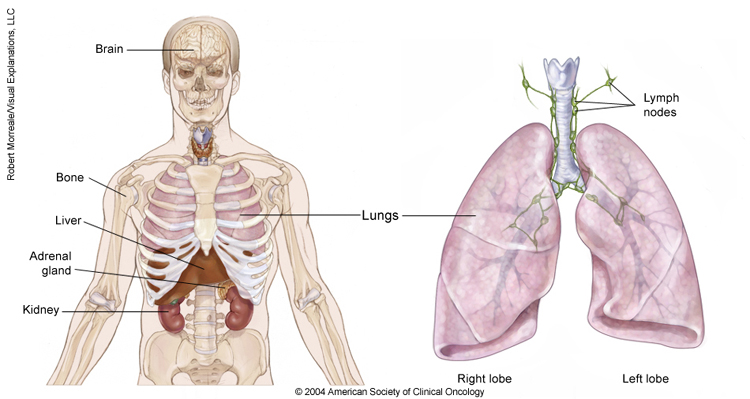ON THIS PAGE: You will find some basic information about this disease and the parts of the body it may affect. This is the first page of Cancer.Net’s Guide to Neuroendocrine Tumor of the Lung. Use the menu to see other pages. Think of that menu as a roadmap for this entire guide.
About the lungs
When a person inhales, the lungs absorb oxygen from the air and bring the oxygen into the bloodstream for delivery to the rest of the body. As the body’s cells use oxygen, they release carbon dioxide. The bloodstream carries carbon dioxide back to the lungs, and the carbon dioxide leaves the body when a person exhales. The lungs contain many different types of cells.
About neuroendocrine tumors
A tumor begins when the DNA of healthy cells is damaged, causing the cells to grow out of control, forming a mass. A cancerous tumor is malignant, meaning it can grow and spread to other parts of the body if it is not found early and treated.
A neuroendocrine tumor (NET) begins in the specialized cells of the body’s neuroendocrine system. These cells have traits of both hormone-producing endocrine cells and nerve cells. They are found throughout the body’s organs and help control many of the body’s functions. Hormones are chemical substances that are carried through the bloodstream to have a specific effect on the activity of other organs or cells in the body.
All NETs have the potential to become metastatic. Most NETs take years to develop and grow slowly. However, some NETs can be fast-growing. See the Stages and Grades section to learn more.
NETs develop most commonly in the lung or the gastrointestinal (GI) tract (learn more about GI tract NETs). NETs can also develop in the pancreas (learn more about NETs of the pancreas) and other locations throughout the body. Rare types of NETs that develop in or on the adrenal glands are called pheochromocytoma or paraganglioma. Learn more about NETs that develop in other parts of the body.
The rest of this guide is about lung NETs. Lung NETs are also called carcinoid tumors or carcinoids.
About lung NETs
While most neuroendocrine cancer begins in the GI tract, about 20% to 30% occur in the lung or bronchial system, which is the airways of the lungs. Only about 2% of those are called typical and atypical lung neuroendocrine tumors. The rest of the lung neuroendocrine cancers are called small cell lung cancer or large cell neuroendocrine carcinoma, or simply lung neuroendocrine carcinoma.
A small number of lung NETs can make high levels of hormone-like substances called neuropeptides and amines. If these substances are released in high amounts, the tumor is called a "functional" NET. A functional NET may lead to a group of symptoms, such as carcinoid syndrome (see Symptoms and Signs) or Cushing syndrome, depending on which hormone-like substance the tumor produces. However, if these substances are released in smaller amounts or not at all, then there may be no symptoms of the developing NET. This type of tumor is called a “non-functional" NET.

Looking for More of an Introduction?
If you would like more of an introduction, explore these related items. Please note that these links will take you to other sections on Cancer.Net:
-
Find a Cancer Doctor. Search for a cancer specialist in your local area using this free database of doctors from the American Society of Clinical Oncology (ASCO).
-
Cancer Terms. Learn what medical phrases and terms used in cancer care and treatment mean.
The next section in this guide is Statistics. It helps explain the number of people who are diagnosed with a lung NET and general survival rates. Use the menu to choose a different section to read in this guide.
